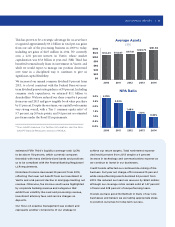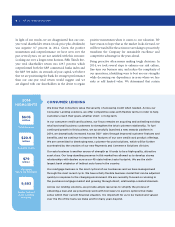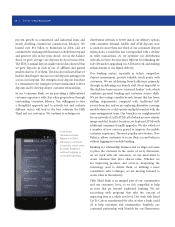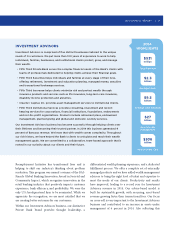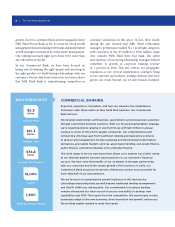Fifth Third Bank 2014 Annual Report Download - page 15
Download and view the complete annual report
Please find page 15 of the 2014 Fifth Third Bank annual report below. You can navigate through the pages in the report by either clicking on the pages listed below, or by using the keyword search tool below to find specific information within the annual report.
2014 ANNUAL REPORT
FINANCIAL CONTENTS
Glossary of Abbreviations and Acronyms 14
Management’s Discussion and Analysis of Financial Condition and Results of Operations
Selected Financial Data 15
Overview 16
Non-GAAP Financial Measures 21
Recent Accounting Standards 23
Critical Accounting Policies 23
Risk Factors 27
Statements of Income Analysis 36
Business Segment Review 43
Fourth Quarter Review 50
Balance Sheet Analysis 52
Risk Management 57
Off-Balance Sheet Arrangements 81
Contractual Obligations and Other Commitments 82
Management’s Assessment as to the Effectiveness of Internal Control over Financial Reporting 83
Reports of Independent Registered Public Accounting Firm 84
Financial Statements
Consolidated Balance Sheets 85
Consolidated Statements of Income 86
Consolidated Statements of Comprehensive Income 87
Consolidated Statements of Changes in Equity 88
Consolidated Statements of Cash Flows 89
Notes to Consolidated Financial Statements
Summary of Significant Accounting and Reporting Policies 90 Commitments, Contingent Liabilities and Guarantees 130
Supplemental Cash Flow Information 100 Legal and Regulatory Proceedings 134
Restrictions on Cash and Dividends 100 Related Party Transactions 136
Securities 101 Income Taxes 137
Loans and Leases 103 Retirement and Benefit Plans 138
Credit Quality and the Allowance for Loan and Lease Losses 104 Accumulated Other Comprehensive Income 143
Bank Premises and Equipment 113 Common, Preferred and Treasury Stock 145
Goodwill 114 Stock-Based Compensation 147
Intangible Assets 115 Other Noninterest Income and Other Noninterest Expense 151
Variable Interest Entities 116 Earnings Per Share 152
Sales of Receivables and Servicing Rights 119 Fair Value Measurements 153
Derivative Financial Instruments 121 Certain Regulatory Requirements and Capital Ratios 164
Offsetting Derivative Financial Instruments 126 Parent Company Financial Statements 165
Other Assets 126 Business Segments 167
Short-Term Borrowings 127 Subsequent Event 170
Long-Term Debt 128
Annual Report on Form 10-K 171
Consolidated Ten Year Comparison 187
Directors and Officers 188
Corporate Information
FORWARD-LOOKING STATEMENTS
This report contains statements that we believe are “forward-looking statements” within the meaning of Section 27A of the Securities Act of 1933, as amended, and Rule 175 promulgated thereunder, and Section
21E of the Securities Exchange Act of 1934, as amended, and Rule 3b-6 promulgated thereunder. These statements relate to our financial condition, results of operations, plans, objectives, future performance or
business. They usually can be identified by the use of forward-looking language such as “will likely result,” “may,” “are expected to,” “is anticipated,” “estimate,” “forecast,” “projected,” “intends to,” or may include
other similar words or phrases such as “believes,” “plans,” “trend,” “objective,” “continue,” “remain,” or similar expressions, or future or conditional verbs such as “will,” “would,” “should,” “could,” “might,”
“can,” or similar verbs. When considering these forward-looking statements, you should keep in mind these risks and uncertainties, as well as any cautionary statements we may make. Moreover, you should treat
these statements as speaking only as of the date they are made and based only on information then actually known to us. There are a number of important factors that could cause future results to differ materially
from historical performance and these forward-looking statements. Factors that might cause such a difference include, but are not limited to: (1) general economic conditions and weakening in the economy,
specifically the real estate market, either nationally or in the states in which Fifth Third, one or more acquired entities and/or the combined company do business, are less favorable than expected; (2) deteriorating
credit quality; (3) political developments, wars or other hostilities may disrupt or increase volatility in securities markets or other economic conditions; (4) changes in the interest rate environment reduce interest
margins; (5) prepayment speeds, loan origination and sale volumes, charge-offs and loan loss provisions; (6) Fifth Third’s ability to maintain required capital levels and adequate sources of funding and liquidity; (7)
maintaining capital requirements and adequate sources of funding and liquidity may limit Fifth Third’s operations and potential growth; (8) changes and trends in capital markets; (9) problems encountered by larger
or similar financial institutions may adversely affect the banking industry and/or Fifth Third; (10) competitive pressures among depository institutions increase significantly; (11) effects of critical accounting policies
and judgments; (12) changes in accounting policies or procedures as may be required by the Financial Accounting Standards Board (FASB) or other regulatory agencies; (13) legislative or regulatory changes or
actions, or significant litigation, adversely affect Fifth Third, one or more acquired entities and/or the combined company or the businesses in which Fifth Third, one or more acquired entities and/or the combined
company are engaged, including the Dodd-Frank Wall Street Reform and Consumer Protection Act; (14) ability to maintain favorable ratings from rating agencies; (15) fluctuation of Fifth Third’s stock price; (16)
ability to attract and retain key personnel; (17) ability to receive dividends from its subsidiaries; (18) potentially dilutive effect of future acquisitions on current shareholders’ ownership of Fifth Third; (19) effects of
accounting or financial results of one or more acquired entities; (20) difficulties from Fifth Third’s investment in, relationship with, and nature of the operations of Vantiv, LLC; (21) loss of income from any sale or
potential sale of businesses that could have an adverse effect on Fifth Third’s earnings and future growth; (22) ability to secure confidential information and deliver products and services through the use of computer
systems and telecommunications networks; and (23) the impact of reputational risk created by these developments on such matters as business generation and retention, funding and liquidity.


